Millar, Sean (2018) Prevalence of major mental illness, substance misuse and homelessness among Irish prisoners. Drugnet Ireland, Issue 67, Autumn 2018, pp. 13-14.
| Preview | Title | Contact |
|---|---|---|
|
PDF (Drugnet 67)
730kB |
There are 12 institutions in the Irish prison system, comprising 10 traditional ‘closed’ institutions and two open centres, which operate with minimal internal and perimeter security. The majority of female prisoners are accommodated in the purpose-built Dóchas Centre adjacent to Mountjoy Prison in Dublin, while the remainder are located in a separate part of Limerick Prison.1 Between 1970 and 2011, the Irish prison population increased by 400%.2 Mental disorders, substance misuse and homelessness have been highlighted as key areas of need among Irish prisoners. However, although the prevalence of these vulnerabilities have been studied by health services and governmental or non-governmental organisations, they have not been systematically reviewed.
Recent Irish research aimed to systematically review studies from Irish prisons that estimate the prevalence of major mental illness, alcohol/substance misuse and homelessness at the time of committal.2 In this study, published in the Irish Journal of Psychological Medicine, healthcare databases were searched for studies quantifying the point prevalence for each outcome of interest. Searches were augmented by scanning bibliographies and searches of governmental and non-governmental websites. Proportional meta-analyses were completed for each outcome. The major findings with regard to these outcomes are discussed below.
Psychotic and major affective disorders
Eight studies with a total sample size of 28,012 prisoners reported data on psychotic disorders. Using a random effects model, the pooled percentage of Irish prisoners suffering from a psychotic disorder was 3.6% (95% CI: 3.0–4.2%). The prevalence in male samples was estimated at 3.8%. Only two studies evaluated prevalence in purely female samples, and estimates for females were 3.9%. Estimates of prevalence in purely remand samples could be extracted from four studies and were 3.9% (see Figure 1).
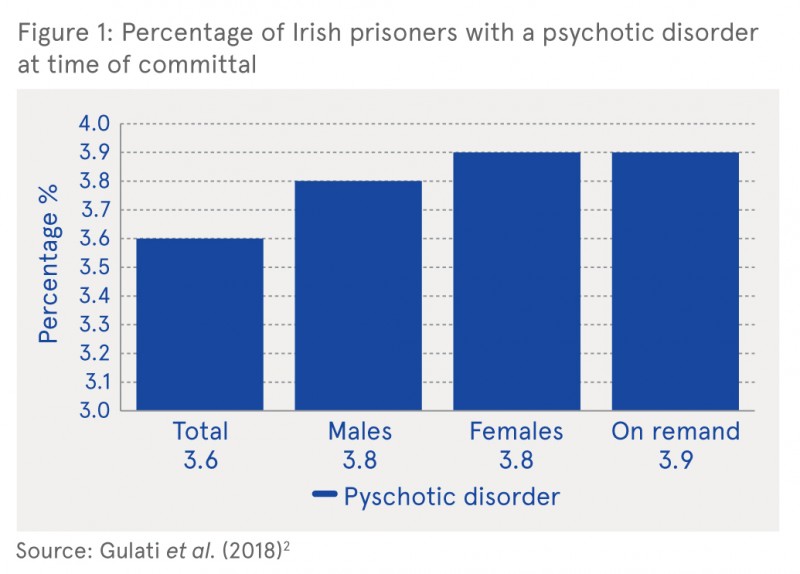
Seven studies with a total sample size of 7,928 prisoners reported on affective disorders. The pooled percentage of prisoners suffering from an affective disorder was 4.3% (95% CI: 2.1–7.1%). Prevalence estimates from male samples were 2.3% and from female samples were 9.1%. Estimates of the prevalence of affective disorders in purely remand samples could only be extracted from two studies and were 2.1% (see Figure 2).
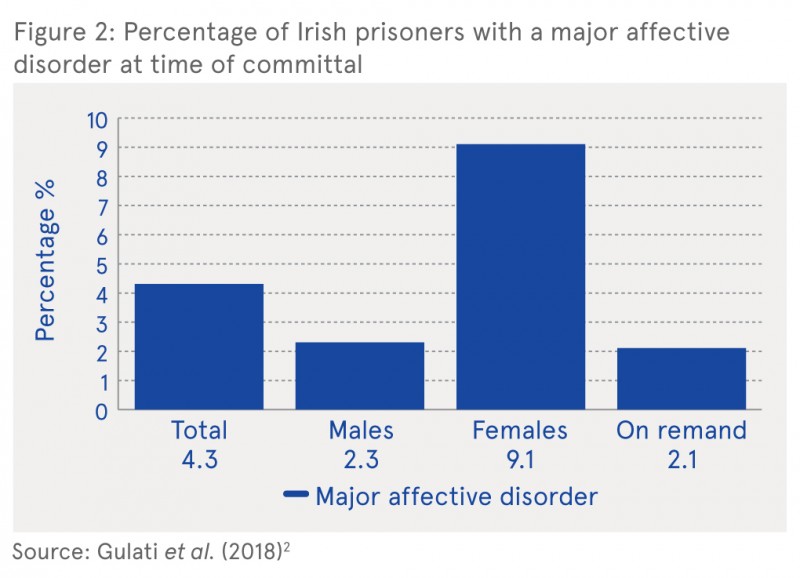
Alcohol and substance use disorders
Six studies with a total sample size of 1,659 prisoners reported on alcohol or substance use disorders. The pooled percentage of prisoners suffering from an alcohol disorder across the six studies was 28.3% (95% CI: 19.9–37.4%) (see Figure 3). The pooled percentage of prisoners reporting a substance use disorder was 50.9% (95% CI: 37.6–64.2%) (see Figure 4).
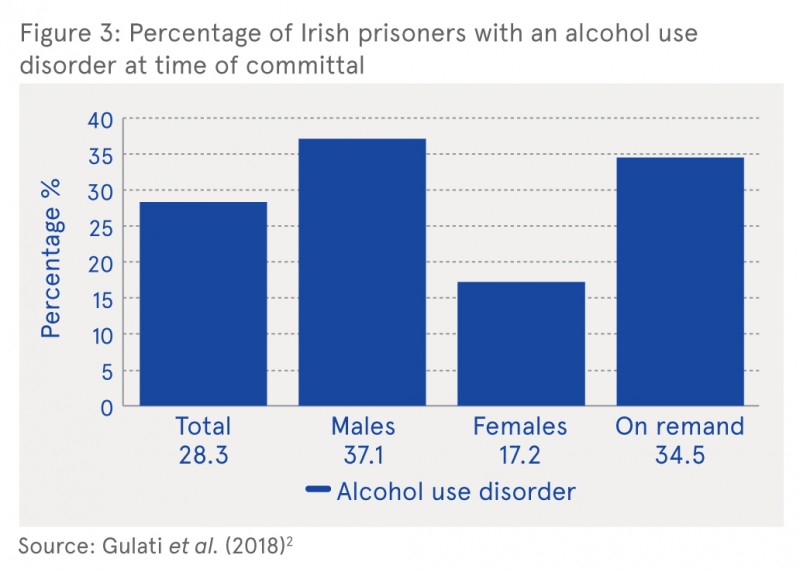
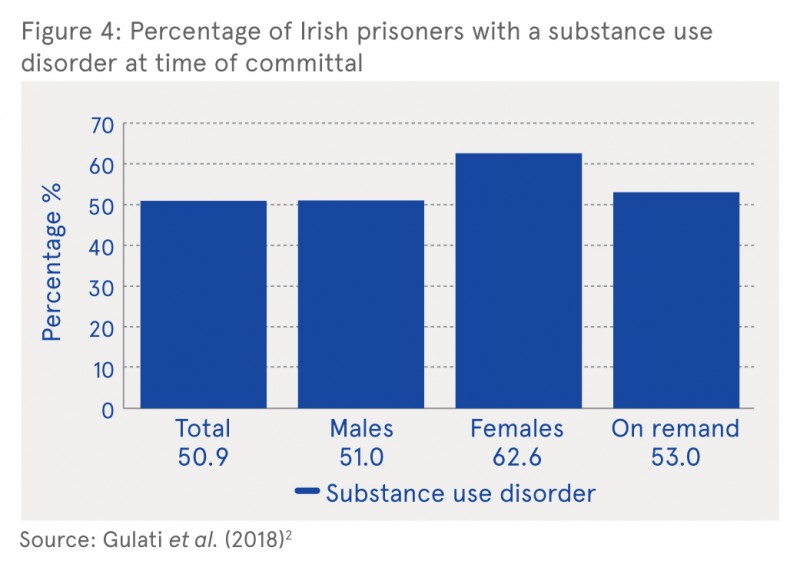
The prevalence estimates for male only samples were 37.1% and 51% for alcohol and substance use disorders, respectively. Two studies evaluated prevalence in purely female samples and estimates for females were 17.2% for alcohol use disorder and 62.6% for substance use disorder. Prevalence estimates for purely remand samples could be extracted from only one study and were 34.5% and 53% for alcohol and substance use disorders, respectively.
Homeless on committal
Five studies with a total sample size of 1,523 prisoners reported on prisoners who were homeless at time of committal. The pooled percentage of homelessness from a random effects model was 17.4% (95% CI: 8.7–28.4%). Prevalence estimates in purely male samples were 8.2%. Only one study evaluated prevalence in a purely female sample and the estimate for females was 18.8%. Prevalence estimates from remand samples could be extracted from two studies and were 23.2% (see Figure 5).
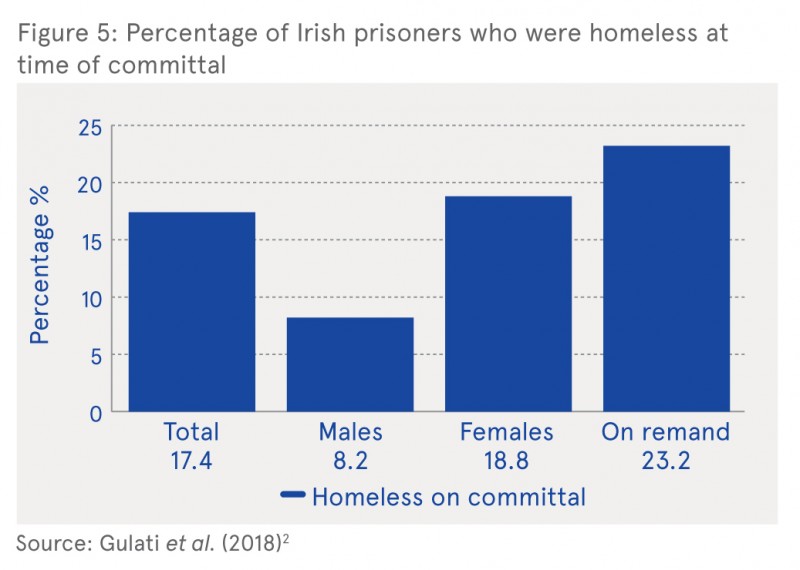
Conclusions
The authors concluded that the study showed prevalence estimates of psychotic illness and substance abuse among Irish prisoners that are in keeping with international estimates of morbidity in prisons, while those for affective disorders are lower. The prevalence of homelessness on committal to Irish prisons is higher than some international estimates.
As rates of psychoses, alcohol/substance misuse and homelessness among Irish prisoners are significantly higher than in the general population, the study highlights the need for improved screening for affective disorders, the development of diversion services, and the consideration of integrated treatment plans for addressing psychiatric and psychosocial need. In particular, the authors suggest that homeless individuals with mental illness are unlikely to seek help or treatment.
In addition, subjects who have an active substance misuse disorder are often excluded from temporary accommodation, which may result in further social decline and increased risk of imprisonment.
1 Irish Prison Service (2018) Irish Prison Service annual report 2017. Longford: Irish Prison Service. https://www.drugsandalcohol.ie/29244/
2 Gulati G, Keating N, O’Neill A, Delaunois I, Meagher D and Dunne CP (2018) The prevalence of major mental illness, substance misuse and homelessness in Irish prisoners: systematic review and meta-analyses. Ir J Psychol Med: 1–11: doi:10.1017/ipm.2018.15. https://www.drugsandalcohol.ie/29009/
G Health and disease > Substance related disorder > Substance related mental health disorder
J Health care, prevention, harm reduction and treatment > Health care programme, service or facility > Prison-based health service
T Demographic characteristics > Homeless person
T Demographic characteristics > Person in prison (prisoner)
T Demographic characteristics > Person who commits a criminal offence (offender)
VA Geographic area > Europe > Ireland
Repository Staff Only: item control page